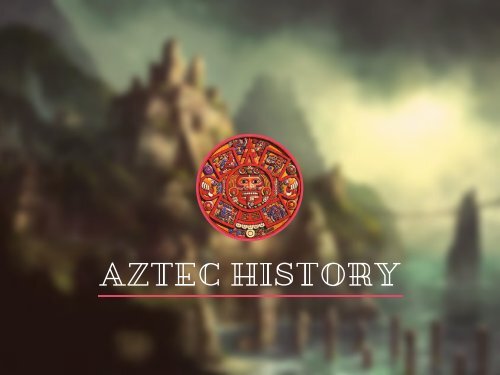Aztec History Book
Free download Aztec History Book
Free download Aztec History Book
Create successful ePaper yourself
Turn your PDF publications into a flip-book with our unique Google optimized e-Paper software.
AZTEC HISTORY
Very Short Introduction employs the disciplines of history, religious studies, and anthropology<br />
This<br />
it illuminates the complexities of <strong>Aztec</strong> life. Readers meet a people highly skilled in sculpture,<br />
as<br />
city planning, poetry, and philosophy, who were also profoundly committed to cosmic<br />
astronomy,<br />
through the thrust of the ceremonial knife and through warfare. Davíd Carrasco looks<br />
regeneration<br />
Spanish accounts that have colored much of the Western narrative to let <strong>Aztec</strong> voices<br />
beyond<br />
about their origin stories, the cosmic significance of their capital city, their methods of child<br />
speak<br />
THE AZTECS:<br />
A VERY SHORT INTRODUCTION<br />
rearing, and the contributions women made to daily life and the empire.
<strong>Aztec</strong>s were fierce, honorable, death-obsessed, and profoundly<br />
The<br />
A famed scholar evokes the life of this complex culture on<br />
religious.<br />
eve of its extinction, when the Spanish arrived and conquered<br />
the<br />
Montezuma and strangling Atahualpa. "It is,<br />
them--imprisoning<br />
question, the most brilliant, the clearest and most readable<br />
without<br />
of <strong>Aztec</strong> life available in any language."--The Observer.<br />
portrayal<br />
DAILY LIFE OF THE AZTECS
three years, the Spanish conquistador Hernán Cortés, leading a<br />
In<br />
hundred Spanish soldiers, overcame a centuries-old empire<br />
few<br />
could put tens of thousands of warriors on the field. Even<br />
that<br />
his god-like reputation had been shattered, and his horses<br />
after<br />
cannons were no longer regarded as supernatural, his ruthless<br />
and<br />
took him on to victory. Yet in the end, his prize was not the<br />
daring<br />
that he had sought, but the destruction of the entire <strong>Aztec</strong><br />
gold<br />
mission statement, a type of statement of purpose, is<br />
civilization.A<br />
statement which is used to communicate the purpose of an<br />
a<br />
Although most of the time it will remain the same for<br />
organisation.<br />
long period of time, it is not uncommon for organisations to<br />
a<br />
their mission statement; this generally happens when an<br />
update<br />
hundreds of years, the history of the conquest of Mexico and<br />
For<br />
defeat of the <strong>Aztec</strong>s has been told in the words of the Spanish<br />
the<br />
Miguel León-Portilla has long been at the forefront of<br />
victors.<br />
that history to include the voices of indigenous<br />
expanding<br />
In this new and updated edition of his classic The Broken<br />
peoples.<br />
León-Portilla has included accounts from native <strong>Aztec</strong><br />
Spears,<br />
across the centuries. These texts bear witness to the<br />
descendants<br />
vitality of an oral tradition that preserves the<br />
extraordinary<br />
of the vanquished instead of the victors. León-Portilla's<br />
viewpoints<br />
Postscript reflects upon the critical importance of these<br />
new<br />
CORTÉS AND THE AZTEC CONQUEST<br />
organisation evolves.<br />
BROKEN SPEARS: THE AZTEC ACCOUNT OF THE<br />
THE<br />
OF MEXICO<br />
CONQUEST<br />
unexpected historical accounts.
this captivating guide, you will discover why Maya have gained<br />
In<br />
worldwide admiration over the many other civilizations that<br />
such<br />
in Mesoamerica at the time. You will learn how the Maya<br />
existed<br />
developed, the major turning points in their 3,000-year-<br />
civilization<br />
history, the mysteries surrounding their demise, and some of<br />
long<br />
unique places where Maya exist to this day.<br />
the<br />
the first part of this book, you will discover the origins of the<br />
In<br />
civilization and the Mesoamerican cultures that may have<br />
Maya<br />
them. You will find out why Maya (out of all the<br />
influenced<br />
tribes that existed in the region at the time) have<br />
different<br />
the imagination of the West so much. The book will reveal<br />
captured<br />
they lived, ate, slept, whom they worshipped, and how they<br />
how<br />
Gods and Symbols of Ancient Mexico and the Maya is the<br />
The<br />
English-language dictionary of Mesoamerican mythology<br />
first-ever<br />
religion. Nearly 300 entries, from accession to yoke, describe<br />
and<br />
main gods and symbols of the Olmecs, Zapotecs, Maya,<br />
the<br />
Mixtecs, Toltecs, and <strong>Aztec</strong>s. Topics range from<br />
Teotihuacanos,<br />
and jester gods to reptile eye and rubber, from creation<br />
jaguar<br />
and sacred places to ritual practices such as<br />
accounts<br />
confession, dance, and pilgrimage. Mary Miller and<br />
bloodletting,<br />
Taube draw on their research in the fast-changing field of<br />
Karl<br />
studies, and on the latest Mexican discoveries, to produce<br />
Maya<br />
authoritative work that will serve as a standard reference for<br />
an<br />
scholars, and travelers. Photographs and illustrations<br />
students,<br />
CIVILIZATION: A CAPTIVATING GUIDE TO MAYA<br />
MAYA<br />
AND MAYA MYTHOLOGY<br />
HISTORY<br />
used herbal medicines and hallucinogenic plants to treat the sick.<br />
ILLUSTRATED DICTIONARY OF THE GODS AND<br />
AN<br />
OF ANCIENT MEXICO AND THE MAYA<br />
SYMBOLS<br />
throughout
an astonishing work of scholarship that reads like an adventure<br />
In<br />
historian Buddy Levy records the last days of the <strong>Aztec</strong><br />
thriller,<br />
and the two men at the center of an epic clash of cultures.<br />
empire<br />
and my companions suffer from a disease of the heart which can<br />
“I<br />
cured only with gold.” —Hernán Cortés<br />
be<br />
is the story of a lost kingdom—a complex and<br />
Conquistador<br />
civilization where floating gardens, immense wealth,<br />
sophisticated<br />
reverence for art stood side by side with bloodstained temples<br />
and<br />
gruesome rites of human sacrifice. It’s the story of Montezuma<br />
and<br />
spiritual, enigmatic, and doomed to misunderstand the<br />
—proud,<br />
he thought a god. Epic in scope, as entertaining as it is<br />
stranger<br />
Conquistador is history at its most riveting.<br />
enlightening,<br />
Townsend gives the complete history of the <strong>Aztec</strong><br />
Richard<br />
rise from humble nomads to empire builders.<br />
civilization’s<br />
a hundred years, the <strong>Aztec</strong>s established the largest empire<br />
Within<br />
Mesoamerican history, and at Tenochtitlan built a vast,<br />
in<br />
city in a lake, a Venice of the New World. The book<br />
shimmering<br />
with a dramatic narrative of the Spanish conquest, as seen<br />
ends<br />
the <strong>Aztec</strong> viewpoint. 16 color and 154 black-and-white<br />
from<br />
illustrations<br />
HERNAN CORTES, KING<br />
CONQUISTADOR:<br />
AND THE LAST STAND OF THE AZTECS<br />
MONTEZUMA,<br />
AZTECS (THIRD EDITION)<br />
THE<br />
PEOPLES AND PLACES)<br />
(ANCIENT
capital of the <strong>Aztec</strong> empire, Tenochtitlan, was, in its era, one of<br />
The<br />
largest cities in the world. Built on an island in the middle of a<br />
the<br />
lake, its population numbered perhaps 150,000, with<br />
shallow<br />
350,000 people in the urban network clustered around the<br />
another<br />
shores. In 1521, at the height of Tenochtitlan's power, which<br />
lake<br />
over much of Central Mexico, Hernando Cortés and his<br />
extended<br />
conquered the city. Cortés boasted to King Charles V of<br />
followers<br />
that Tenochtitlan was "destroyed and razed to the ground."<br />
Spain<br />
CHACO MERIDIAN: ONE THOUSAND YEARS OF POLITICAL<br />
THE<br />
RELIGIOUS POWER IN THE ANCIENT SOUTHWEST<br />
AND<br />
this return to his lively, provocative reconceptualization of the<br />
In<br />
of Chaco Canyon and its monumental 11th-century<br />
meaning<br />
Stephen H. Lekson expands—over time and distance—<br />
structures,<br />
understanding of the political and economic integration of the<br />
our<br />
Southwest.<br />
American<br />
argument that Chaco did not stand alone, but rather was<br />
Lekson’s<br />
first of three capitals in a vast networked region incorporating<br />
the<br />
of the Pueblo world has gained credence over the past 15<br />
most<br />
Here, he marshals new evidence and new interpretations to<br />
years.<br />
the case for ritual astronomical alignment of monumental<br />
further<br />
and cities, great ceremonial roads, and the shift of the<br />
structures<br />
capital first from Chaco Canyon to the <strong>Aztec</strong> Ruins site<br />
regional<br />
then to Paquimé, all located on the same longitudinal<br />
and<br />
meridian.<br />
DEATH OF AZTEC TENOCHTITLAN, THE LIFE OF<br />
THE<br />
CITY<br />
MEXICO<br />
But was it?
written in the <strong>Aztec</strong> language, Nahuatl, in 1552, this<br />
Originally<br />
codex was the first herbal and medical text compiled in the<br />
classic<br />
World. The author of this extraordinarily rare and valuable<br />
New<br />
was Martín de la Cruz, an <strong>Aztec</strong> physician, whose work<br />
document<br />
subsequently translated into Latin by an <strong>Aztec</strong> nobleman, Juan<br />
was<br />
Badiano.<br />
book was translated into English in 1939 by William Gates. In<br />
The<br />
pages are centuries-old <strong>Aztec</strong> remedies for boils, hair loss,<br />
these<br />
insomnia, sore throats, hiccups, gout, lesions, wounds,<br />
cataracts,<br />
diseases, tumors, and scores of other ailments. Over 180 black-<br />
joint<br />
figures of the plants augment the text, along with 38 full<br />
and-white<br />
illustrations made specially for the Gates edition. Additional<br />
color<br />
include an introduction to the Mexican botanical<br />
supplements<br />
an analytical index of the plants, and a new Introduction by<br />
system,<br />
<strong>Aztec</strong>s were fierce, honorable, death-obsessed, and<br />
The<br />
religious. A famed scholar evokes the life of this<br />
profoundly<br />
culture on the eve of its extinction, when the Spanish<br />
complex<br />
and conquered them--imprisoning Montezuma and<br />
arrived<br />
Atahualpa. "It is, without question, the most brilliant, the<br />
strangling<br />
and most readable portrayal of <strong>Aztec</strong> life available in any<br />
clearest<br />
AN AZTEC HERBAL: THE CLASSIC CODEX OF 1552<br />
anthropologist Bruce Byland of the City University of New York.<br />
DAILY LIFE OF THE AZTECS<br />
language."--The Observer.











